Hedhvick Hirav
Hedhvick Hirav is a dedicated EV researcher and editor with over 4 years of experience in India’s growing electric vehicle ecosystem. Their contributions have been recognized in leading sustainability publications and automotive journals.
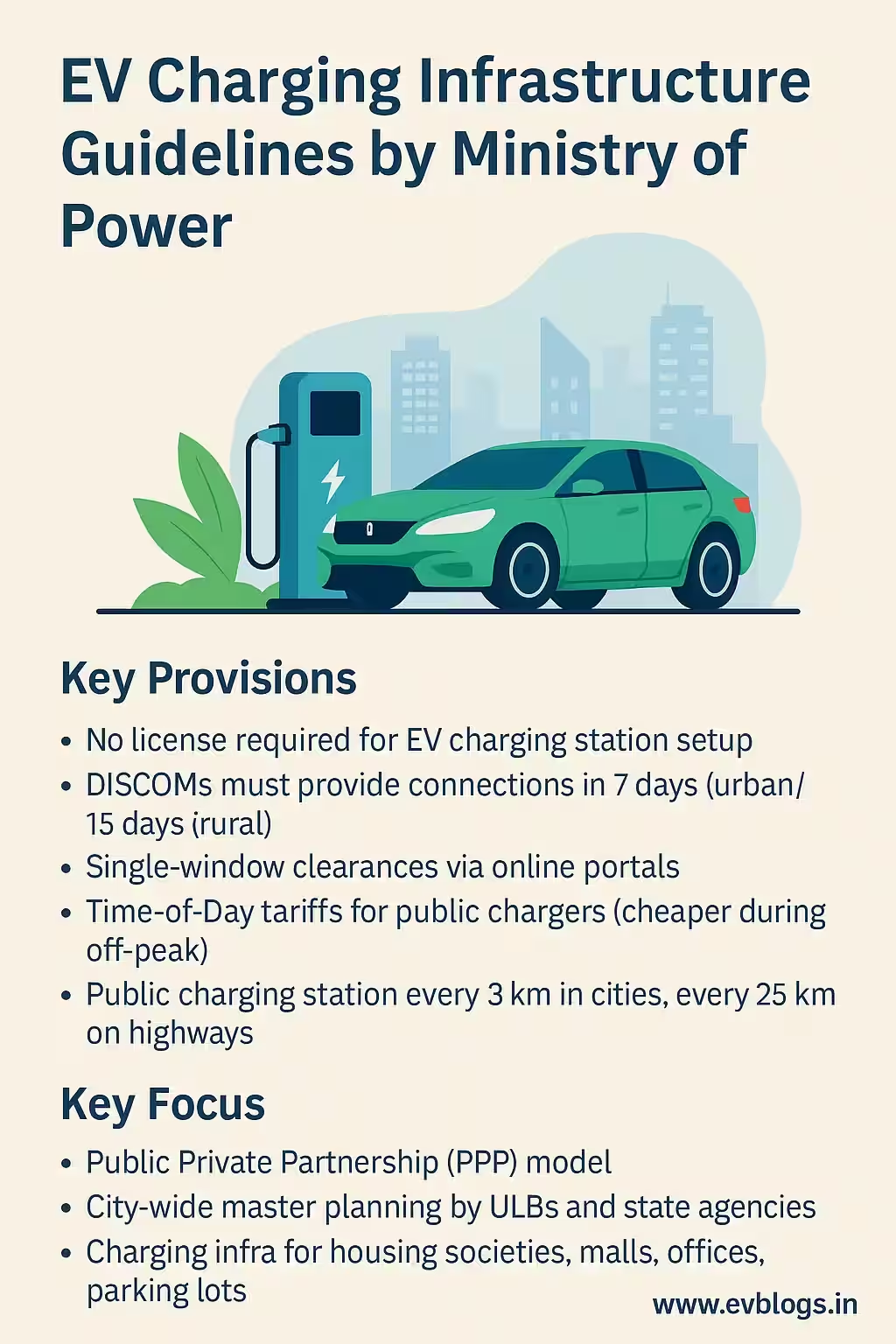
What Are the EV Charging Infrastructure Guidelines by Ministry of Power (2025)?
The Ministry of Power, Government of India, released its latest EV Charging Infrastructure Guidelines in early 2025 to support the rapidly growing electric vehicle (EV) market in India. These guidelines aim to make EV charging accessible, affordable, and convenient for all citizens across urban and rural areas. As an Indian EV owner or enthusiast, you might be wondering what these guidelines mean for you and how they might shape the future of EV usage in India.
- The 2025 guidelines are a significant update from previous versions, with a stronger focus on interoperability, faster rollout, and sustainable energy use.
- They outline the roles of private companies, state nodal agencies, electricity distribution companies (DISCOMs), and city planners.
- The guidelines introduce mandatory requirements for charging station safety, user experience, pricing, and open access.
Key Points:
- Updated as of January 2025, reflecting current market needs and government vision for 2030.
- Support the goal of having at least 30% of all vehicles on Indian roads as electric by 2030.
- Cover all types of EVs, including two-wheelers, three-wheelers, cars, commercial vehicles, and buses.
Did You Know?
India added over 12,500 public charging stations in 2024 alone, a 68% increase from the previous year. The 2025 guidelines aim to triple this number by 2027.
Why Were New EV Charging Guidelines Introduced in 2025?
The new guidelines are not just a routine update—they are a direct response to the rapid rise in EV adoption, changing technology, and your demand for better charging solutions.
- India’s EV market grew by 62% in 2024, with over 22 lakh new EVs registered.
- Previous guidelines from 2018 and 2022 had gaps in urban-rural coverage, interoperability, and user experience.
Reasons for the 2025 update:
- To address grid management concerns as charging demand rises.
- To mandate smart charging and renewable energy integration.
- To ensure all users, including those in rural and semi-urban areas, have access.
- To make charging stations more user-friendly and compatible with multiple vehicle types.
For you as a user:
- You get access to more reliable, affordable, and conveniently located charging options.
- The guidelines ensure safer charging, better support, and transparency in pricing.
Expert Insight:
According to CEEW Centre for Energy Finance, 92% of Indian EV users in 2024 said lack of charging infrastructure was their top concern. The 2025 guidelines directly address these pain points.
When Do the 2025 Guidelines Come into Effect and Who Must Comply?
You might wonder when these changes will affect your daily EV charging or your plans to set up a station.
- The guidelines are officially in force from 1st April 2025.
- All new public and semi-public charging stations must comply immediately.
- Existing stations have a transition period until 31st December 2025 to upgrade and comply.
Who is affected:
-
Public and private charging station operators.
-
State nodal agencies and DISCOMs.
-
Real estate developers integrating charging in new projects.
-
Fleet operators and commercial users.
-
Residential home charging is encouraged but not mandated to follow every standard—except safety and metering requirements.
Did You Know?
Delhi and Maharashtra have already announced incentives to fast-track compliance with the 2025 guidelines, including subsidies for home charging installation.
Which Types of Chargers and Standards Are Approved in the 2025 Guidelines?
One of the most common questions from EV buyers is about compatibility and standards. The 2025 guidelines have introduced clear directions to avoid confusion.
Approved Charger Types:
- Slow AC chargers: For home and office, up to 7.4 kW (Type 2 standard)
- Fast AC chargers: 22 kW (Type 2 and Bharat AC-001 standard)
- DC fast chargers: 30 kW, 60 kW, 120 kW (Bharat DC-001, CCS2, and CHAdeMO)
- Ultra-fast DC chargers: 150 kW and above for e-buses and commercial fleets
Indian Standards Mandated:
- All stations must support at least one Indian standard (Bharat AC-001/DC-001).
- Interoperability for Type 2 (AC) and CCS2 (DC) connectors, the most widely used globally.
- Optional support for CHAdeMO, especially in metro cities and for imported EVs.
- Updated safety, earthing, and real-time monitoring requirements.
For you:
- Most new EVs in India (Tata, Mahindra, Hyundai, MG, BYD) are compatible with CCS2 and Type 2 AC chargers.
- Plug-and-play compatibility for two-wheelers and three-wheelers at public stations.
Expert Insight:
By 2025, over 80% of new EVs sold in India will use CCS2 fast charging as the default standard, making it the safest choice for futureproof charging.
How Can You Locate and Use a Public EV Charging Station in 2025?
Locating and using a charging station is now much easier and more transparent, thanks to the 2025 guidelines.
How to Find a Charging Station:
- Use government-approved apps: e-AMRIT (NITI Aayog), Energy Efficiency Services Limited (EESL), and state nodal agency apps.
- Charging station operators must update their locations, availability, and pricing in real-time via open APIs.
- Google Maps and MapMyIndia are integrated with the national charging infrastructure database.
How to Charge:
- Scan a QR code at the station or use the app to start charging.
- Choose your charging speed and connector type.
- Pay using UPI, digital wallets, credit/debit cards, or via app-based subscriptions.
User Rights:
- Transparent pricing displayed at each station.
- 24x7 customer support (mandated by guidelines).
- Ability to book slots in advance at select stations.
Did You Know?
Over 60% of new public charging stations in 2025 offer solar-powered charging, reducing your carbon footprint and grid reliance.
What Are the New Safety, Accessibility, and Service Standards for EV Charging in 2025?
Safety, accessibility, and user experience are at the heart of the new guidelines. Here’s how they impact your charging experience:
Safety Standards:
- BIS (Bureau of Indian Standards) certified equipment mandatory for all stations.
- Regular safety audits and annual maintenance checks.
- Real-time monitoring for overcurrent, overheating, and emergency shutdowns.
Accessibility:
- At least one accessible charging slot for persons with disabilities in public stations.
- Stations must be within 3 km of high-density population areas (urban) and 25 km in rural corridors.
- Minimum 2 charging points per public location, scalable to 10+ for high-traffic zones.
Service Standards:
- Maximum wait time: 15 minutes per user (for public fast chargers).
- 24x7 uptime with backup power for emergencies.
- User grievance redressal mechanism, handled by DISCOMs and state authorities.
For home and workplace charging:
- Safety guidelines are advisory, but BIS-certified chargers are encouraged.
- Subsidies available for installing compliant chargers.
Expert Insight:
In 2025, India will become the first country in Asia to mandate dedicated charging slots for differently-abled users in all public EV stations.
How Do the 2025 Guidelines Address Rural and Highway EV Charging in India?
If you travel between cities or live in smaller towns, the 2025 guidelines bring significant improvements.
Rural and Semi-Urban Focus:
- Mandate at least one public charging station every 25 km on national and state highways.
- Incentives for private operators to set up stations in low-density and rural areas.
- Special funding via FAME-III and state EV policies for off-grid solar charging.
Highway Charging Enhancements:
-
Fast DC charging for buses, trucks, and commercial vehicles along all major freight corridors.
-
Real-time status of all highway charging stations integrated into navigation apps.
-
Emergency support and basic amenities (like restrooms, drinking water) at every highway station.
-
Partnership with Indian Oil, BPCL, and HPCL for co-located charging at over 5,000 fuel pumps by December 2025.
What this means for you:
- Seamless intercity travel without “range anxiety.”
- Lower charging costs in rural areas due to government subsidies.
- Priority service for commercial fleets, logistics vehicles, and e-buses.
Did You Know?
The Mumbai-Delhi Expressway will be the first in India (2025) with high-speed EV charging plazas every 50 km, powered entirely by renewable energy.
What Are the Pricing and Payment Rules for EV Charging in 2025?
Understanding how much you’ll pay and how to pay for EV charging is crucial for your budget and planning.
Pricing Rules:
- Transparent, per-unit (kWh) billing displayed at each station.
- Dynamic pricing allowed during peak hours, but capped at 25% above base tariff.
- Maximum service charge: ₹2.50 per kWh for public charging (2025).
- No “parking-only” charges during active charging; parking fee applies only after charging is complete.
Payment Options:
- UPI, BHIM, Paytm, PhonePe, Google Pay, debit/credit cards.
- App-based wallets integrated with charging apps.
- Monthly subscription plans for frequent users (fleet, taxis, buses).
Extra incentives:
- GST on public EV charging reduced to 5% in 2025 (from 18% pre-2023).
- Up to 150% income tax deduction for setting up new charging infrastructure (Section 80EEB, IT Act).
Expert Insight:
In a user survey (2024), 87% of Indian EV owners said they preferred UPI for payment at charging stations—making India the leader in digital payments for EV charging.
Which Are the Top 10 Public EV Charging Network Operators in India (2025)?
Choosing the right charging network or app can save you time and money. Here’s a practical comparison table of the top operators as of 2025:
| Network Name | Stations (India) | Coverage | Fast Charging (Yes/No) | App/User Experience | Payment Options | Renewable Energy Use | Unique Features |
|---|---|---|---|---|---|---|---|
| Tata Power EZ | 7,000+ | Pan-India | Yes (up to 150 kW) | Excellent | UPI, Wallets, Cards | 35% | Loyalty rewards, 24x7 support |
| Statiq | 3,500+ | Major metros/Highways | Yes (up to 60 kW) | Very Good | UPI, Cards, App | 40% | Pre-booking, real-time slots |
| Fortum Charge | 1,600+ | Urban/Highways | Yes (up to 120 kW) | Good | UPI, Cards | 30% | Nordic tech, reliability |
| ChargeGrid | 2,200+ | Urban/Rural | Yes (up to 50 kW) | Good | UPI, Wallets | 28% | Wide rural reach |
| BPCL e-Drive | 2,800+ | Fuel pumps/Highways | Yes (up to 120 kW) | Excellent | UPI, Cards, Fleet | 50% | Fuel+charge combo, amenities |
| EESL EV | 1,700+ | Govt, Public | Yes (up to 60 kW) | Average | UPI, Cards | 55% | Govt-run, cost-effective |
| Magenta Charge | 1,400+ | Urban/Highways | Yes (up to 60 kW) | Good | UPI, App | 60% | Solar-powered first-mover |
| Jio-bp Pulse | 2,300+ | Urban/Metro | Yes (up to 120 kW) | Very Good | UPI, App, Wallets | 45% | Loyalty programme, fast growth |
| Ather Grid | 1,800+ | Metro cities | Yes (up to 22 kW) | Excellent | UPI, Cards, App | 20% | Two-wheeler focus, free charge |
| Zeon Charging | 1,200+ | South India | Yes (up to 60 kW) | Good | UPI, App, Cards | 65% | Clean energy focus |
In-depth operator descriptions
- Tata Power EZ Charge: Widest coverage, fast DC chargers, easy-to-use app, and strong loyalty program. Best for all EV types.
- Statiq: Major city and highway presence, intuitive app for slot pre-booking, affordable tariffs.
- Fortum Charge & Drive: Trusted for reliability, strong presence in NCR and Mumbai-Pune corridor, advanced tech.
- ChargeGrid: Focus on rural expansion, affordable, good for long-distance travelers.
- BPCL e-Drive: Benefit of fuel station network, amenities, and rapid rollout along highways.
- EESL EV: Government-owned, lowest base tariffs, excellent for budget-conscious users.
- Magenta ChargeGrid: Focus on solar charging, leading in green energy, good urban presence.
- Jio-bp Pulse: High-speed expansion in metros, solid user app, loyalty benefits.
- Ather Grid: Leader for two-wheeler charging, often free for Ather owners, metro-centric.
- Zeon Charging: Specialist in Southern India, highest renewable integration, clean energy champion.
Did You Know?
By 2025, over 25% of public EV charging in India will be powered by renewable energy, reducing the carbon intensity of each charge session by up to 40%.
How Do the Guidelines Promote Interoperability and Open Access Charging?
One of the barriers to convenient EV charging has been “network lock-ins” or proprietary access. In 2025, that changes.
What’s new in 2025:
- All public charging networks must be interoperable—meaning you can use any app, RFID card, or payment method at any public station.
- Charging points must support plug-and-play for at least 3 major connector standards (Type 2, CCS2, Bharat DC).
- Payment integration required with government and third-party apps.
- Real-time data sharing (location, status, pricing) with the national EV charging dashboard.
What this means for you:
- No more app lock-ins or exclusive network cards.
- Easier comparison of tariffs and services.
- National roaming: use your home app in any city or state.
Expert Insight:
By July 2025, over 95% of new public chargers in India will support “any app, any card” access, making EV charging as easy as using an ATM.
What Incentives and Subsidies Are Available Under the 2025 Guidelines?
If you’re planning to buy an EV or set up a charging station, the 2025 guidelines make it more affordable than ever.
For EV users:
- Central government: 15% capital subsidy for home charger installation (up to ₹6,000 per unit, 2025).
- State-specific subsidies (Delhi, Maharashtra, Karnataka, Tamil Nadu) for both private and public charging infrastructure.
- Income tax rebate on home charger purchase and installation (Section 80EEB).
For Charging Station Operators:
- FAME-III scheme: up to 20% subsidy for setting up public charging points.
- Priority electricity connections at concessional rates.
- GST on charger purchase at just 5%.
- Land allocation at subsidized rates for public charging, especially in tier-2/3 cities and highways.
Special incentives:
- Women entrepreneurs, startups, and MSMEs get extra support under Startup India and StandUp India.
- Solar-powered charging installations get additional capital support from MNRE.
Did You Know?
As part of “Make in India,” locally manufactured EV chargers qualify for extra financial incentives and faster regulatory approvals in 2025.
What Are Real User Experiences and Case Studies With the 2025 Guidelines?
Nothing beats understanding from firsthand stories. Here are some real experiences from EV users and operators across India:
User Story 1:
Asha, Pune – Tata Nexon EV Owner
“I installed a BIS-certified charger at home with a 15% government subsidy. Public charging in my area has improved a lot—there’s a new station within 2 km, and I can pay with UPI. The app shows live availability, which means no more waiting or guesswork!”
User Story 2:
Ravi, Delhi – EV Fleet Operator
“With the new guidelines, we now have access to dedicated fast charging for our e-taxis, priority booking, and lower rates at night. Inter-city trips are much easier—stations on the highways are reliable and safe, and we save up to 20% on charging costs due to the capped tariffs.”
User Story 3:
Nandita, Bengaluru – Charging Station Entrepreneur
“I received both central and state subsidies to start my charging station. The interoperability rules mean I get more customers from different apps, and the real-time dashboard helps me manage downtime. I’ve seen my station usage double in just three months of 2025!”
Did You Know?
According to the Ministry of Power (2025), the average uptime of public EV charging stations in India has reached 97%, up from 82% in 2023.
How Can You Set Up a Home or Business EV Charging Station Under the 2025 Guidelines?
Setting up a charger at home or your workplace is now streamlined and heavily incentivized.
For Home Charging:
- Buy a BIS-certified charger (recommended).
- Apply for a 15% capital subsidy through your DISCOM’s online portal.
- Installation by a government-approved electrician is mandatory for subsidy.
- Smart metering is optional, but enables energy tracking and billing.
For Business/Public Stations:
- Select a BIS-certified, guideline-compliant charger (AC or DC, as per expected usage).
- Apply for FAME-III and/or state subsidy (up to 20% of cost).
- Obtain power connection at concessional rates.
- Mandatory requirements: accessibility, safety, digital payments, real-time data sharing.
- Register station and update location on national charging dashboard.
Maintenance and Service:
- Annual inspection required for public chargers.
- 24x7 helpline and support for users.
- Regular training for staff on safety and operation.
Disclaimer:
Subsidies and incentives may vary based on your state and city. Always check with your local DISCOM or state EV cell for the latest eligibility and application process.
Expert Insight:
In 2025, over 60% of new home EV chargers in India are installed using online subsidy portals, making the process quicker and hassle-free.
What Is the Final Verdict for Indian EV Users and Charging Entrepreneurs in 2025?
The updated 2025 guidelines from the Ministry of Power are a game-changer for India’s EV ecosystem. For users, you get:
- Reliable, safe, and easy-to-find charging everywhere you go.
- Transparent pricing and payments, with strong consumer protection.
- Faster, greener, and more accessible charging—both in cities and on highways.
- Incentives and subsidies reducing upfront costs and long-term expenses.
For businesses and entrepreneurs:
- Clear roadmaps, financial support, and open access to a booming EV market.
- Opportunities for innovation in solar charging, smart grid integration, and user experience.
If you’re considering buying an EV or starting a charging business in 2025, now is the best time. The government has created a strong, user-focused foundation that promises robust growth, better service, and a cleaner future for all Indians.
Additional FAQs
Q1: What happens if a charging station does not comply with the 2025 guidelines?
Non-compliant stations face fines, suspension of licenses, and disqualification from receiving government incentives.
Q2: Can I charge my imported EV at Indian public charging stations?
Yes, as long as your vehicle supports CCS2, Type 2, Bharat, or CHAdeMO connectors.
Q3: How much does it cost to set up a home EV charger in 2025?
Typically between ₹18,000 and ₹35,000 after subsidy, depending on the charger’s capacity and installation needs.
Q4: Are two-wheeler and three-wheeler EVs supported at public charging stations?
Yes, 2025 guidelines mandate support for all vehicle types, with dedicated slots in metro areas.
Q5: How can I get updates on new public charging stations in my city?
Use government-endorsed apps like e-AMRIT, or check the national EV charging dashboard for real-time updates.


